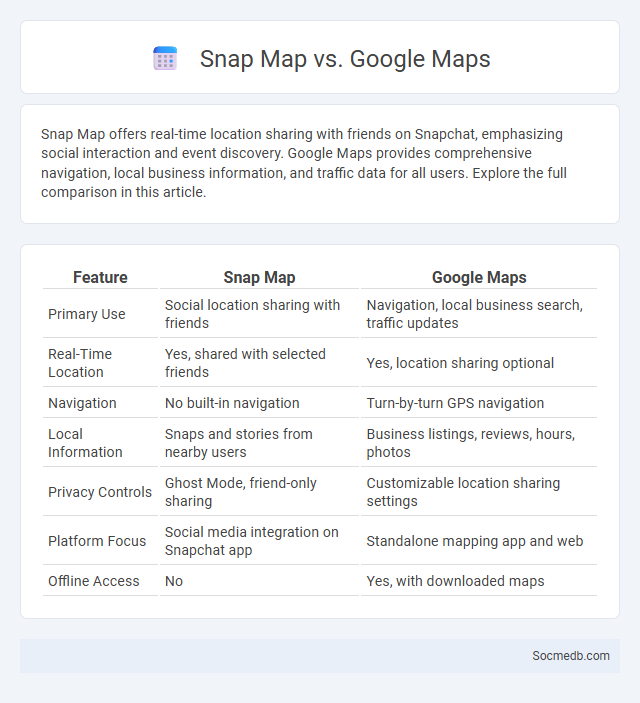
Photo illustration: Snap Map vs Google Maps
Snap Map offers real-time location sharing with friends on Snapchat, emphasizing social interaction and event discovery. Google Maps provides comprehensive navigation, local business information, and traffic data for all users. Explore the full comparison in this article.
Table of Comparison
| Feature | Snap Map | Google Maps |
|---|---|---|
| Primary Use | Social location sharing with friends | Navigation, local business search, traffic updates |
| Real-Time Location | Yes, shared with selected friends | Yes, location sharing optional |
| Navigation | No built-in navigation | Turn-by-turn GPS navigation |
| Local Information | Snaps and stories from nearby users | Business listings, reviews, hours, photos |
| Privacy Controls | Ghost Mode, friend-only sharing | Customizable location sharing settings |
| Platform Focus | Social media integration on Snapchat app | Standalone mapping app and web |
| Offline Access | No | Yes, with downloaded maps |
Introduction to Snap Map and Google Maps
Snap Map and Google Maps offer innovative ways to navigate and explore your surroundings using real-time location data. Snap Map integrates social media by allowing you to see friends' locations and share your own, making social interactions more dynamic and location-based. Google Maps excels in providing detailed geographic information, traffic updates, and route planning, enhancing your ability to travel efficiently and discover new places.
Key Features: Snap Map vs Google Maps
Snap Map offers real-time location sharing with friends, integrating social media features like status updates and event notifications directly on the map interface. Google Maps provides comprehensive navigation tools, traffic conditions, and business information, with advanced route planning and offline maps for broader usability. Your choice depends on whether you prioritize social interaction or detailed navigation capabilities.
User Interface and Experience Comparison
Social media platforms like Facebook, Instagram, and TikTok each design their user interfaces to maximize engagement through intuitive navigation and visually appealing layouts. Instagram emphasizes a clean, image-focused experience with simple swipe gestures, whereas TikTok's interface centers on endless vertical video scrolls to capture attention quickly. Your choice depends on whether you prefer streamlined content discovery or more interactive, multimedia-rich environments tailored to your social habits.
Real-Time Location Sharing: Pros and Cons
Real-time location sharing on social media platforms enhances user connectivity by enabling friends and family to track each other's whereabouts instantly, which is invaluable during emergencies or coordinating meetups. However, this feature raises significant privacy concerns as it can lead to unwanted surveillance, stalking, or data misuse by third parties, compromising user security. Balancing convenience and privacy through stringent settings and user consent is essential to mitigate risks associated with real-time location sharing.
Privacy and Security: Which Map Wins?
When comparing social media platforms' privacy and security, Signal offers the highest level of encryption with end-to-end messaging, surpassing Facebook and Twitter's standard protections. TikTok, despite vast user engagement, faces scrutiny for data privacy concerns, highlighting the importance of transparent data policies. Users seeking robust security protocols favor platforms utilizing advanced encryption technologies and regular security audits to safeguard personal information.
Social Integration: Snap Map vs Google Maps
Snap Map offers real-time social integration by allowing you to share your location and see friends' activities on a dynamic, interactive map, enhancing social connectivity. Google Maps integrates social features like location sharing and user reviews but emphasizes navigation and local information over continuous social interaction. Your choice depends on whether you prioritize social presence with friends (Snap Map) or comprehensive navigation with community insights (Google Maps).
Map Accuracy and Navigation Capabilities
Map accuracy and navigation capabilities are crucial for enhancing your social media experience by enabling precise location tagging and real-time route updates. Advanced GPS technology and AI-driven algorithms improve the reliability of suggested paths and nearby recommendations, ensuring that users find accurate destinations effortlessly. Integrating these features into social platforms boosts user engagement by allowing seamless location sharing and interactive navigation within posts and stories.
Customization and Personalization Options
Social media platforms offer extensive customization and personalization options, enabling you to tailor your feed based on interests, behavior, and interactions. Algorithms analyze your preferences to deliver relevant content, ads, and friend suggestions that enhance engagement. These features create a more immersive experience while ensuring that your social media environment reflects your unique tastes and priorities.
Use Cases: Social vs Navigation Focus
Social media platforms excel in enhancing user engagement through interactive content, real-time communication, and community building features that foster connection and collaboration. Navigation-focused applications prioritize seamless user journeys with intuitive menus, personalized recommendations, and efficient search functionalities that streamline access to specific information. Understanding your goal--whether to build vibrant social interactions or to facilitate rapid information retrieval--determines the ideal platform design for optimal user experience.
Conclusion: Choosing the Best Map for Your Needs
Selecting the best social media map depends on your specific goals, whether it's tracking trending topics, analyzing user engagement, or visualizing demographic data. Tools like Hootsuite Insights, Brandwatch, and Sprout Social offer advanced features tailored for detailed social media mapping and analytics. Evaluating these platforms based on functionality, data accuracy, and integration capabilities ensures optimal decision-making for targeted social media strategy development.
 socmedb.com
socmedb.com